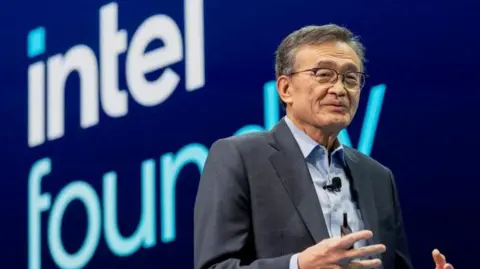In a significant move reflecting the ever-evolving dynamics of the technology sector, Intel, a leading American computer chip manufacturer, has seen its shares soar following the announcement that SoftBank, a Japanese technology investment conglomerate, is purchasing a $2 billion stake in the company. This investment is seen as a strategic effort to bolster Intel’s commitment to semiconductor innovation within the United States.
The announcement comes on the heels of reports indicating discussions involving the Trump administration regarding a potential 10% stake in Intel as well. This would be facilitated by converting government grants into equity, further entrenching government interests in the semiconductor industry amidst a landscape of heightened scrutiny and regulatory focus. The U.S. Department of Commerce has been observing the chip industry closely, particularly given national security concerns and competition from countries like China.
The potential implications of the government’s participation in Intel are broad, especially as it seeks to establish a flagship manufacturing hub in Ohio. A spokesperson from the White House has urged caution, labeling initial reports as speculation unless accompanied by official confirmation. This sentiment creates a layer of uncertainty but also highlights the increasing role of government in shaping the tech industry’s future.
SoftBank’s substantial investment entails acquiring shares at a price of $23 each. In a joint statement, both companies underscored their commitment to technological advancement and innovation in the semiconductor space. The infusion of capital from SoftBank could assist Intel in navigating its challenges and fortifying its competitive position in an industry marked by rapid changes and fierce competition.
Adding to the intrigue of this situation was Intel CEO Lip-Bu Tan’s recent interactions with President Donald Trump and his cabinet. These discussions reportedly followed Trump’s public criticism of Tan, which he articulated through a call for the CEO’s resignation due to perceived conflicts stemming from his prior associations with China. This public fallout underscores the heightened political oversight in the tech sector, particularly as global supply chains continue to be disrupted by geopolitical tensions.
Furthermore, the pressures on U.S. semiconductor companies have been palpable, as evidenced by recent agreements between major players like Nvidia and AMD securing export licenses to China whilst agreeing to remit 15% of their revenues earned in the region to the U.S. government. This arrangement indicates a significant evolution in the operational landscape for American chip manufacturers as they jockey for regulatory compliance while striving to maintain their foothold in lucrative international markets.
The backdrop against which these financial maneuvers and strategic partnerships unfold is one of increasing public and governmental concern regarding technological self-sufficiency and national security. The ongoing discussions surrounding Intel and SoftBank highlight a broader narrative on the critical nature of semiconductor manufacturing capabilities in an era increasingly defined by technological dependency and innovation.
As SoftBank positions itself within Intel, the investment signals a pronounced confidence in America’s technological capabilities, suggesting that crucial advancements in semiconductor technology will likely remain at the forefront of economic discussions. The convergence of financial powerhouses and technology leaders embodies a critical phase in the U.S. tech industry, where collaboration among corporate giants and government entities could ultimately redefine landscapes both domestically and globally.
With SoftBank’s considerable financial backing, Intel is now potentially fortified against ongoing market fluctuations and competitive pressures, enabling it to innovate and expand its manufacturing prowess. As the situation evolves, stakeholders across the tech landscape will be watching closely to see how these developments unfold amidst a backdrop of governmental scrutiny and market dynamics that shape the future of global technology industries.











